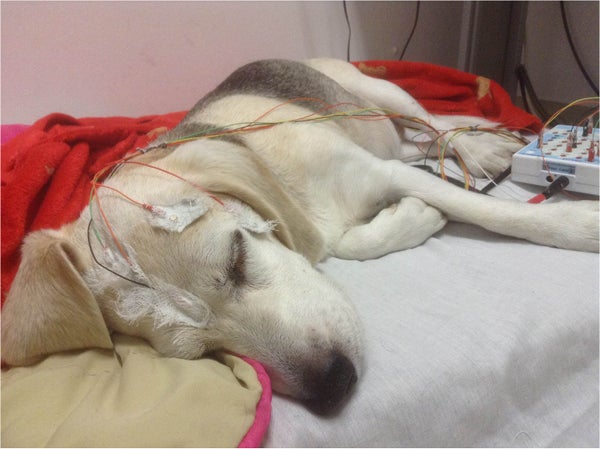This article was published in Scientific American’s former blog network and reflects the views of the author, not necessarily those of Scientific American
A Harvard Medical School professor recently rocked the Internet: “Since dogs are generally extremely attached to their human owners, it’s likely your dog is dreaming of your face, your smell and of pleasing or annoying you,” psychologist Deirdre Barrett told People magazine.
And then hearts everywhere exploded.
Barrett’s sleep research focuses on humans, while an interest in evolutionary psychology helps her consider the sleep of non-human mammals. Both have similar sleep cycles, she notes, which could suggest parallels in sleep quality or experience.
On supporting science journalism
If you're enjoying this article, consider supporting our award-winning journalism by subscribing. By purchasing a subscription you are helping to ensure the future of impactful stories about the discoveries and ideas shaping our world today.
But an open access study in Scientific Reports out yesterday moves away from extrapolation and toward hard data. Researchers in Hungary have devised a way to non-invasively peer into the sleeping dog’s brain to explore the content and function of their sleep.
Sleep in dogs is good for a number of things, including, but not limited to cuteness, cuteness, and more cuteness. But you’ve also probably heard that sleep is good for memory. Before a big test we’re often told, “Get a good night’s rest,” which is actually shorthand for—give memory consolidation a chance. “Memory consolidation” is the process where your brain pulls together pieces of information and packages them into memories that can be used in the future.
Memory is also important for dogs. Working dogs need to learn—and retain—a wide variety of job-specific skills, and companion dogs often learn basic skills to successfully live alongside humans. When a dog learns something new, can sleep help the dog perform those skills better? Should training sessions incorporate naptime?
Anna Kis of the Hungarian Academy of Sciences and colleagues—including members of the well-known Family Dog Project—set out to explore the relationship between sleep and memory in companion dogs. Their study involved two experiments: the first gave dogs a learning task and then peered into their sleep via non-invasive electroencephalogram (EEG)—a test that detects brain electrical activity using small electrodes attached to the scalp. The second experiment explored whether different type of post-learning activities (such as sleep) affect memory consolidation, both in the short- and long-term. All experiments were performed with consenting companion dogs and their helpful owners.
First up, the sleep study, also known as polysomnography if you want to be fancy about it. Fifteen companion dogs participated in both a learning and a non-learning condition. The experimenters taught the dogs the commands for “sit” and “lie down” in a foreign language (English). As you’d expect, no learning took place in the non-learning condition—dogs simply practiced the “sit” and “lie down” commands that they already knew in Hungarian. Nothing new. Old hat. (Most dogs don’t wear hats. Old collar?)
For the critical phase of the experiment, dogs went to sleep (gosh I love science). Dog snoozing-related brain activity was then monitored over the next three hours. Afterwards, dogs in the learning condition were retested on “sit” and “lie down” in English to determine whether sleep helped the dogs process what they had learned.

Recording setup. Credit: Anna Kis
Not only did the sleep affect dogs’ learning, the learning affected dogs’ sleep. Dogs did better responding to “sit” and “lie down” in English after taking a snooze. But even before the dogs in the learning condition were retested, two notable wave patterns stood out in the EEG spectrum in the non-REM phase (the dreamless part of sleep). There was an increase of delta power, similar to what is found in humans, and a decrease in alpha activity, which could suggest “an increase in sleep depth after learning.”
These two findings are related. Dogs learned a task, which alters their brain activity during sleep, then they performed better on the task. “This suggests that the newly acquired information is re-processed and consolidated during sleep,” Kis explained over email. More specifically, the correlation between the post-sleep improvement in performance and certain EEG patterns “is the strongest indicator that the changes in sleep EEG we see after learning are functionally related to memory consolidation,” added Kis.
Neat. Taking a snooze can improve subsequent performance (at least for this type of command learning task). But how do we make things stick? Is sleep more or less effective than other strategies for retaining information? A second behavioral experiment investigated the effect of different post-learning activities (including sleep) on subsequent memory.
Fifty-three new companion dogs learned “sit” and “lie down” to new words (again, English). Dogs were then put in one of four different post-learning groups, spending the next hour either sleeping, walking, learning more (learning new behaviors via the luring training method), or eating from and playing with a Kong dog toy. When the hour was up, dogs were retested on the English commands they’d just learned.*
The type of post-learning activity seemed to affect dog performance in the short term, but not exactly as the researchers had expected. In the short term, both sleeping and walking improved subsequent performance, while more learning and Kong play did not.
On the other hand, when dogs came back a week later, presumably after many sleeps, dogs in the sleep, walk, and Kong play conditions showed marked improvement with the English commands. Dogs who had done more learning did not improve.

Values >0 indicate a performance improvement at the given occasion, while values <0 indicate a decreased performance. Figure 3 Credit: Kis et al. 2017
Dog lovers often think about learning and obedience in terms of dogs doing it “right” or “wrong.” Factors surrounding learning, this study reminds, can affect memory consolidation and later performance.
Kis recommends: “Learning a new command should be followed by an activity that does not interfere with this new memory trace (e.g. sleeping, walking, playing–but not learning other things) in order to achieve the highest subsequent performance in the long run.”
At the same time, Kis noted that dogs in the sleeping condition might have performed even better if the nap extended beyond an hour (possibly for memory consolidation to fully take place), or if, after waking up, the dogs had a few more minutes to shake off their sleepiness before performing the tasks again. Human-sleep scientists refer to this latter phenomenon of decreased cognitive performance in the few minutes after waking up as “sleep inertia.” Don’t pretend you’ve never woken up, walked to the bathroom, and tried to brush your teeth with your comb. Since no sleep inertia interval has been established for dogs, Kis says, they can’t rule out the possibility that the dogs were still sleep zombies when they were retested.
Non-invasive studies of dogs and sleep are new. We haven’t yet studied whether your dog is dreaming of your face or your glorious smell, but if you care about learning in dogs, this study suggests you give sleep a chance.
-- -- --
* Maybe you’re wondering why there wasn’t a condition after learning where dogs simply rested—rather than slept—and then had their memory tested. This ‘resting’ awake condition is typically found in human memory consolidation studies because it’s the closest match to the ‘sleep’ condition. But this condition was not included for dogs, the researchers explain, “as preventing dogs from falling asleep while requested to stay in a laying position for one hour would presumably induce stress in the animals. Stress is known to have an impact on memory, and also raises animal welfare issues, thus we decided to avoid such a condition.”
References
